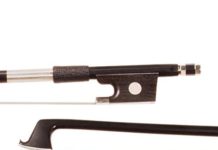Cellos have the greatest solo repertoire in orchestras after violins, though many cellists would argue that their pieces are better. The smoothness of the instrument, the moving sounds and human-like characterizations help make the instrument highly-useful in many forms of music. Thus, it is only logical that somewhere along the way, the cello concerto was birthed: a beautiful arrangement and balance of a solo cello, backed by a full orchestra. There are many amazing cello concertos, some surprisingly beautiful. Today we are going to talk about the best cello concertos of all the time.
1. Dvořák – Cello Concerto in B Minor
Composer: Antonín Leopold Dvořák
Dvořák’s Cello Concerto in B minor is our favorite cello concerto. Dvořák composed it in his last academic year, but only after much insistence from his friend, cellist Hanuš Wihan. Before that, he didn’t compose in this genre (he didn’t quite like the sound of the upper and lower registers of the instrument). Wihan, upon reviewing the score, made several suggestions and improvements, but Dvorak resisted the advice of his friend, (and, later, ordered his publishers to make no alterations, either), and the piece premiered in Queen’s Hall in London in 1896, with Wihan as the principal cellist. It is an amazing example of contrapuntal treatment and magically unique.
2. Boccherini – Cello Concerto in B Flat
Composer: Luigi Rodolfo Boccherini
While having so many amazing works, Boccherini will always be remembered for his amazing work of Cello Concerto in B flat. This masterpiece is considered one of the finest concertos written for the cello. Boccherinis utilized the double stop (where the cellist plays two notes simultaneously), as well as the upper registers of the cello. However, rather than compose large jumps – which can often be difficult for the cellist to accomplish, and results in less-than-pleasing sounds – Boccherini transitions into the upper registers slowly and smoothly, creating a much more pleasing register change. With its elegance and charm, it is a highly-expressive piece.
3. Elgar – Cello Concerto in E Minor
Composer: Edward Elgar
Elgar’s cello concerto has na almost human tone in a cello composition. The Elgar Cello Concerto, immensely complex, and introspective, was composed in 1919, premiering in London in October of the same year (disastrously, as it turns out, and it would be another year before the concerto was performed again). The Elgar cello concerto starts with a line between cello and clarinet. It is structured in four movements instead of the usual three. There are several flowing and sorrowful themes, and Elgar poured his emotions into this work.
4. Lalo – Cello Concerto in D Minor
Composer: Edouard Lalo
Edouard Lalo was one of the most visionary and thoughtful composers of his time. He earned his reputation for composing interesting and moving concertos long before this specific cello concerto in d minor. This piece of work was written by him in 1877. It is reminiscent of early Beethoven, at least partially. Its bold, bombastic opening and contrasting sections of elegiac lyricism, punctuated with orchestra hits and flourishes, create for an emotionally-dissonant listening experience. [Editor’s note: This is possibly my favorite piece in this list.]
5. Schumann – Cello Concerto in A minor
Composer: Robert Schumann
This marvellous concerto was composed during Schumann’s residency in Düsseldorf, and he composed it in only fourteen days. While he ever heard it performed live (Schumann died in 1856, and the piece premiered in 1860, it has been hailed as one of his masterpieces. The concerto is in three movements, and the entire composition uses several themes and motifs, tying all three movements together. This was a technique uncommon in his day. There is a playful smoothness in the cellos solos, and the piece will no doubt move its listeners for years to come.
6. Shostakovich – Cello Concerto No.1
Composer: Dmitry Shostakovich
Shostakovich’s name is no doubt familiar to most classical music enthusiasts, as he considered to be one of the greatest symphonic composers of the twentieth century. This particular masterpiece was composed in 1959, a highly productive era for Shostakovich. Utilizing interesting harmonics, double stopping, and difficult – virtuosic, even – thumb positioning. It is considered one of his greatest compositions, as it has Shostakovich’s signature materials, blended with traditional Russian folk-music voicings. This powerfully expressive concerto is a significant addition to the musical landscape.
7. Haydn – Cello Concerto No.1
Composer: Franz Joseph Haydn
Although fragments of the concerto have existed since 1765, the complete manuscript was not discovered until 1961. Since its premier in the mid-twentieth century, the concerto has become a favorite piece for chamber orchestras and cellists. Its first movement, like so many of Haydn’s other works, has a lightness to it – a “bouncy” quality, if you will, characteristic of Haydn. The cello themes are passionate and vigorous, and excite the soul.
8. Shostakovich – Cello Concerto No.2
Composer: Dmitri Shostakovich
Dmitri Shostakovich wrote this cello concerto in the spring of 1966, and performed in the fall of the same year. Utilizing unusual solo instruments – such as wood blocks, the tambourine, and the xylophone – Shostakovich brings a jarring but satisfying contrast between the cello and percussive instruments. The concerto is an example of the fairly symmetrical concerto, as it opens with a quiet, brooding cello line, and ends just as quietly.
Other Well-Known Cello Pieces
The remaining pieces on this list are no cello concertos, but a mix of sonatas and other solo works that are quite well-known.
1. Johann Sebastian Bach – Six Unaccompanied Cello Suites, BWV 1007 – 1012
Composer: Johann Sebastian Bach
The Prelude from the first Cello Suite is one of the most widely recognized cello pieces around. The size suites were composed by JS Bach sometime between 1717-1723, but were not performed for nearly 200 years. Then, in the 1930s, Pablo Casals performed and recorded them. After that, other cellists performed their version of the suites. The suites have been transposed for other instruments including viola.
2. Camille Saint-Saëns – The Swan
Composer: Camille Saint-Saëns
Camille Saint-Saëns wrote “The Swan” in 1886 as part of the “The Carnival of the Animals”. The pieces were originally composed for private performance, but have since exploded in popularity. In fact, “The Swan” was the only piece from the collection released during Saint-Saëns’ lifetime.
It’s not a challenging piece, but captures the beautiful sounds of the cello, making the cello almost sound like it’s singing.
Table of Contents







Expected nothing else from the first place. I would have put the first one by Shostakovich on place 2 though.